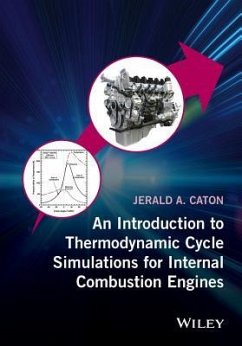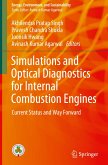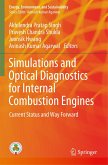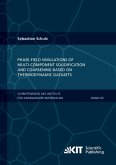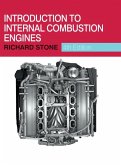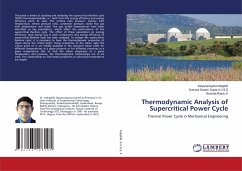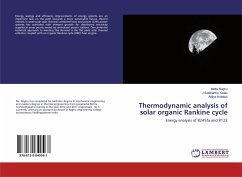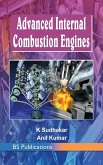Jerald A Caton
An Introduction to Thermodynamic Cycle Simulations for Internal Combustion Engines
Jerald A Caton
An Introduction to Thermodynamic Cycle Simulations for Internal Combustion Engines
- Gebundenes Buch
- Merkliste
- Auf die Merkliste
- Bewerten Bewerten
- Teilen
- Produkt teilen
- Produkterinnerung
- Produkterinnerung
This book provides an introduction to basic thermodynamic engine cycle simulations, and provides a substantial set of results. Key features includes comprehensive and detailed documentation of the mathematical foundations and solutions required for thermodynamic engine cycle simulations. The book includes a thorough presentation of results based on the second law of thermodynamics as well as results for advanced, high efficiency engines. Case studies that illustrate the use of engine cycle simulations are also provided.
Andere Kunden interessierten sich auch für
![Simulations and Optical Diagnostics for Internal Combustion Engines Simulations and Optical Diagnostics for Internal Combustion Engines]() Simulations and Optical Diagnostics for Internal Combustion Engines75,99 €
Simulations and Optical Diagnostics for Internal Combustion Engines75,99 €![Simulations and Optical Diagnostics for Internal Combustion Engines Simulations and Optical Diagnostics for Internal Combustion Engines]() Simulations and Optical Diagnostics for Internal Combustion Engines75,99 €
Simulations and Optical Diagnostics for Internal Combustion Engines75,99 €![Phase-field simulations of multi-component solidification and coarsening based on thermodynamic datasets Phase-field simulations of multi-component solidification and coarsening based on thermodynamic datasets]() Sebastian SchulzPhase-field simulations of multi-component solidification and coarsening based on thermodynamic datasets46,00 €
Sebastian SchulzPhase-field simulations of multi-component solidification and coarsening based on thermodynamic datasets46,00 €![Introduction to Internal Combustion Engines Introduction to Internal Combustion Engines]() Richard StoneIntroduction to Internal Combustion Engines111,99 €
Richard StoneIntroduction to Internal Combustion Engines111,99 €![Thermodynamic Analysis of Supercritical Power Cycle Thermodynamic Analysis of Supercritical Power Cycle]() Satyanarayana IndigibilliThermodynamic Analysis of Supercritical Power Cycle50,99 €
Satyanarayana IndigibilliThermodynamic Analysis of Supercritical Power Cycle50,99 €![Thermodynamic analysis of solar organic Rankine cycle Thermodynamic analysis of solar organic Rankine cycle]() Metta RaghuThermodynamic analysis of solar organic Rankine cycle26,99 €
Metta RaghuThermodynamic analysis of solar organic Rankine cycle26,99 €![Advanced Internal Combustion Engines Advanced Internal Combustion Engines]() K. SudhakarAdvanced Internal Combustion Engines54,99 €
K. SudhakarAdvanced Internal Combustion Engines54,99 €-
-
-
This book provides an introduction to basic thermodynamic engine cycle simulations, and provides a substantial set of results. Key features includes comprehensive and detailed documentation of the mathematical foundations and solutions required for thermodynamic engine cycle simulations. The book includes a thorough presentation of results based on the second law of thermodynamics as well as results for advanced, high efficiency engines. Case studies that illustrate the use of engine cycle simulations are also provided.
Produktdetails
- Produktdetails
- Verlag: Wiley
- Seitenzahl: 384
- Erscheinungstermin: 14. Dezember 2015
- Englisch
- Abmessung: 246mm x 168mm x 23mm
- Gewicht: 726g
- ISBN-13: 9781119037569
- ISBN-10: 1119037565
- Artikelnr.: 42967804
- Herstellerkennzeichnung
- Libri GmbH
- Europaallee 1
- 36244 Bad Hersfeld
- gpsr@libri.de
- Verlag: Wiley
- Seitenzahl: 384
- Erscheinungstermin: 14. Dezember 2015
- Englisch
- Abmessung: 246mm x 168mm x 23mm
- Gewicht: 726g
- ISBN-13: 9781119037569
- ISBN-10: 1119037565
- Artikelnr.: 42967804
- Herstellerkennzeichnung
- Libri GmbH
- Europaallee 1
- 36244 Bad Hersfeld
- gpsr@libri.de
Jerald A. Caton, Gulf Oil/Thomas A. Dietz Professorship at Texas A&M University, USA Professor Caton has been at Texas A&M University since September 1979 in the Department of Mechanical Engineering. He is holder of the Gulf Oil/Thomas A. Dietz Professorship (2007). He teaches and conducts research in the area of IC engines, thermodynamics, cogeneration and power plans. He received his BS and MS degrees from the University of California, Berkeley, and his PhD from the Massachusetts Institute of Technology. Professor Caton is a Fellow of both ASME and SAE. He has been focusing on the development and use of engine cycle simulations since 1997.
Preface xiii
1 Introduction 1
1.1 Reasons for Studying Engines 1
1.2 Engine Types and Operation 2
1.3 Reasons for Cycle Simulations 3
1.3.1 Educational Value 3
1.3.2 Guide Experimentation 3
1.3.3 Only Technique to Study Certain Variables 4
1.3.4 Complete Extensive Parametric Studies 4
1.3.5 Opportunities for Optimization 4
1.3.6 Simulations for Real?]time Control 4
1.3.7 Summary 5
1.4 Brief Comments on the History of Simulations 5
1.5 Overview of Book Content 6
2 Overview of Engines and Their Operation 9
2.1 Goals of Engine Designs 9
2.2 Engine Classifications by Applications 10
2.3 Engine Characteristics 11
2.4 Basic Engine Components 12
2.5 Engine Operating Cycles 12
2.6 Performance Parameters 12
2.6.1 Work, Power, and Torque 12
2.6.2 Mean Effective Pressure 15
2.6.3 Thermal Efficiencies 16
2.6.4 Specific Fuel Consumption 17
2.6.5 Other Parameters 17
2.7 Summary 18
3 Overview of Engine Cycle Simulations 19
3.1 Introduction 19
3.2 Ideal (Air Standard) Cycle Analyses 19
3.3 Thermodynamic Engine Cycle Simulations 21
3.4 Quasi?]dimensional Thermodynamic Engine Cycle Simulations 22
3.5 Multi?]dimensional Simulations 23
3.6 Commercial Products 24
3.6.1 Thermodynamic Simulations 24
3.6.2 Multi?]dimensional Simulations 25
3.7 Summary 26
Appendix 3.A: A Brief Summary of the Thermodynamics of the "Otto" Cycle
Analysis 29
4 Properties of the Working Fluids 37
4.1 Introduction 37
4.2 Unburned Mixture Composition 37
4.2.1 Oxygen?]containing Fuels 40
4.2.2 Oxidizers 41
4.2.3 Fuels 41
4.3 Burned Mixture ("Frozen" Composition) 42
4.4 Equilibrium Composition 43
4.5 Determinations of the Thermodynamic Properties 46
4.6 Results for the Thermodynamic Properties 47
4.7 Summary 61
5 Thermodynamic Formulations 63
5.1 Introduction 63
5.2 Approximations and Assumptions 64
5.3 Formulations 65
5.3.1 One?]Zone Formulation 65
5.3.2 Two?]Zone Formulation 67
5.3.3 Three?]Zone Formulation 72
5.4 Comments on the Three Formulations 77
5.5 Summary 77
6 Items and Procedures for Solutions 79
6.1 Introduction 79
6.2 Items Needed to Solve the Energy Equations 79
6.2.1 Thermodynamic Properties 79
6.2.2 Kinematics 80
6.2.3 Combustion Process (Mass Fraction Burned) 82
6.2.4 Cylinder Heat Transfer 85
6.2.5 Mass Flow Rates 86
6.2.6 Mass Conservation 89
6.2.7 Friction 89
6.2.8 Pollutant Calculations 94
6.2.9 Other Sub?]models 94
6.3 Numerical Solution 94
6.3.1 Initial and Boundary Conditions 95
6.3.2 Internal Consistency Checks 96
6.4 Summary 96
7 Basic Results 99
7.1 Introduction 99
7.2 Engine Specifications and Operating Conditions 99
7.3 Results and Discussion 101
7.3.1 Cylinder Volumes, Pressures, and Temperatures 102
7.3.2 Cylinder Masses and Flow Rates 106
7.3.3 Specific Enthalpy and Internal Energy 108
7.3.4 Molecular Masses, Gas Constants, and Mole Fractions 110
7.3.5 Energy Distribution and Work 114
7.4 Summary and Conclusions 116
8 Performance Results 119
8.1 Introduction 119
8.2 Engine and Operating Conditions 119
8.3 Performance Results (Part I)-Functions of Load and Speed 119
8.4 Performance Results (Part II)-Functions of Operating/Design Parameters
129
8.4.1 Combustion Timing 129
8.4.2 Compression Ratio 131
8.4.3 Equivalence Ratio 133
8.4.4 Burn Duration 135
8.4.5 Inlet Temperature 135
8.4.6 Residual Mass Fraction 136
8.4.7 Exhaust Pressure 136
8.4.8 Exhaust Gas Temperature 140
8.4.9 Exhaust Gas Recirculation 142
8.4.10 Pumping Work 145
8.5 Summary and Conclusions 149
9 Second Law Results 153
9.1 Introduction 153
9.2 Exergy 153
9.3 Previous Literature 154
9.4 Formulation of Second Law Analyses 154
9.5 Results from the Second Law Analyses 158
9.5.1 Basic Results 158
9.5.2 Parametric Results 163
9.5.3 Auxiliary Comments 174
9.6 Summary and Conclusions 176
10 Other Engine Combustion Processes 179
10.1 Introduction 179
10.2 Diesel Engine Combustion 179
10.3 Best Features from SI and CI Engines 180
10.4 Other Combustion Processes 181
10.4.1 Stratified Charge Combustion 181
10.4.2 Low Temperature Combustion 181
10.5 Challenges of Alternative Combustion Processes 182
10.6 Applications of the Simulations for Other Combustion Processes 183
10.7 Summary 184
11 Case Studies: Introduction 187
11.1 Case Studies 187
11.2 Common Elements of the Case Studies 188
11.3 General Methodology of the Case Studies 189
12 Combustion: Heat Release and Phasing 191
12.1 Introduction 191
12.2 Engine and Operating Conditions 191
12.3 Part I: Heat Release Schedule 191
12.3.1 Results for the Heat Release Rate 197
12.4 Part II: Combustion Phasing 205
12.4.1 Results for Combustion Phasing 206
12.5 Summary and Conclusions 221
13 Cylinder Heat Transfer 225
13.1 Introduction 225
13.2 Basic Relations 226
13.3 Previous Literature 227
13.3.1 Woschni Correlation 228
13.3.2 Summary of Correlations 229
13.4 Results and Discussion 230
13.4.1 Conventional Engine 230
13.4.2 Engines Utilizing Low Heat Rejection Concepts 241
13.4.3 Engines Utilizing Adiabatic EGR 247
13.5 Summary and Conclusions 250
14 Fuels 253
14.1 Introduction 253
14.2 Fuel Specifications 254
14.3 Engine and Operating Conditions 255
14.4 Results and Discussion 255
14.4.1 Assumptions and Constraints 255
14.4.2 Basic Results 255
14.4.3 Engine Performance Results 259
14.4.4 Second Law Results 266
14.5 Summary and Conclusions 268
Appendix 14.A: Energy and Exergy Distributions for the Eight Fuels at the
Base Case Conditions (bmep = 325 kPa, 2000 rpm, ¿ = 1.0 and MBT timing) 269
15 Oxygen?]Enriched Air 275
15.1 Introduction 275
15.2 Previous Literature 276
15.3 Engine and Operating Conditions 277
15.4 Results and Discussion 277
15.4.1 Strategy for This Study 278
15.4.2 Basic Thermodynamic Properties 278
15.4.3 Base Engine Performance 280
15.4.4 Parametric Engine Performance 283
15.4.5 Nitric Oxide Emissions 289
15.5 Summary and Conclusions 291
16 Overexpanded Engine 295
16.1 Introduction 295
16.2 Engine, Constraints, and Approach 296
16.2.1 Engine and Operating Conditions 296
16.2.2 Constraints 296
16.2.3 Approach 296
16.3 Results and Discussion 297
16.3.1 Part Load 297
16.3.2 Wide?]Open Throttle 304
16.4 Summary and Conclusions 309
17 Nitric Oxide Emissions 311
17.1 Introduction 311
17.2 Nitric Oxide Kinetics 312
17.2.1 Thermal Nitric Oxide Mechanism 312
17.2.2 "Prompt" Nitric Oxide Mechanism 312
17.2.3 Nitrous Oxide Route Mechanism 313
17.2.4 Fuel Nitrogen Mechanism 313
17.3 Nitric Oxide Computations 313
17.3.1 Kinetic Rates 315
17.4 Engine and Operating Conditions 316
17.5 Results and Discussion 317
17.5.1 Basic Chemical Kinetic Results 317
17.5.2 Time?]Resolved Nitric Oxide Results 320
17.5.3 Engine Nitric Oxide Results 324
17.6 Summary and Conclusions 329
18 High Efficiency Engines 333
18.1 Introduction 333
18.2 Engine and Operating Conditions 334
18.3 Results and Discussion 336
18.3.1 Overall Assessment 336
18.3.2 Effects of Individual Parameters 343
18.3.3 Emissions and Exergy 347
18.3.4 Effects of Combustion Parameters 351
18.4 Summary and Conclusions 353
19 Summary: Thermodynamics of Engines 355
19.1 Summaries of Chapters 355
19.2 Fundamental Thermodynamic Foundations of IC Engines 356
Item 1: Heat Engines versus Chemical Conversion Devices 356
Item 2: Air?]Standard Cycles 357
Item 3: Importance of Compression Ratio 357
Item 4: Importance of the Ratio of Specific Heats 359
Item 5: Cylinder Heat Transfer 360
Item 6: The Potential of a Low Heat Rejection Engine 360
Item 7: Lean Operation and the Use of EGR 361
Item 8: Insights from the Second Law of Thermodynamics 361
Item 9: Timing of the Combustion Process 362
Item 10: Technical Assessments of Engine Concepts 362
19.3 Concluding Remarks 362
Index 363
1 Introduction 1
1.1 Reasons for Studying Engines 1
1.2 Engine Types and Operation 2
1.3 Reasons for Cycle Simulations 3
1.3.1 Educational Value 3
1.3.2 Guide Experimentation 3
1.3.3 Only Technique to Study Certain Variables 4
1.3.4 Complete Extensive Parametric Studies 4
1.3.5 Opportunities for Optimization 4
1.3.6 Simulations for Real?]time Control 4
1.3.7 Summary 5
1.4 Brief Comments on the History of Simulations 5
1.5 Overview of Book Content 6
2 Overview of Engines and Their Operation 9
2.1 Goals of Engine Designs 9
2.2 Engine Classifications by Applications 10
2.3 Engine Characteristics 11
2.4 Basic Engine Components 12
2.5 Engine Operating Cycles 12
2.6 Performance Parameters 12
2.6.1 Work, Power, and Torque 12
2.6.2 Mean Effective Pressure 15
2.6.3 Thermal Efficiencies 16
2.6.4 Specific Fuel Consumption 17
2.6.5 Other Parameters 17
2.7 Summary 18
3 Overview of Engine Cycle Simulations 19
3.1 Introduction 19
3.2 Ideal (Air Standard) Cycle Analyses 19
3.3 Thermodynamic Engine Cycle Simulations 21
3.4 Quasi?]dimensional Thermodynamic Engine Cycle Simulations 22
3.5 Multi?]dimensional Simulations 23
3.6 Commercial Products 24
3.6.1 Thermodynamic Simulations 24
3.6.2 Multi?]dimensional Simulations 25
3.7 Summary 26
Appendix 3.A: A Brief Summary of the Thermodynamics of the "Otto" Cycle
Analysis 29
4 Properties of the Working Fluids 37
4.1 Introduction 37
4.2 Unburned Mixture Composition 37
4.2.1 Oxygen?]containing Fuels 40
4.2.2 Oxidizers 41
4.2.3 Fuels 41
4.3 Burned Mixture ("Frozen" Composition) 42
4.4 Equilibrium Composition 43
4.5 Determinations of the Thermodynamic Properties 46
4.6 Results for the Thermodynamic Properties 47
4.7 Summary 61
5 Thermodynamic Formulations 63
5.1 Introduction 63
5.2 Approximations and Assumptions 64
5.3 Formulations 65
5.3.1 One?]Zone Formulation 65
5.3.2 Two?]Zone Formulation 67
5.3.3 Three?]Zone Formulation 72
5.4 Comments on the Three Formulations 77
5.5 Summary 77
6 Items and Procedures for Solutions 79
6.1 Introduction 79
6.2 Items Needed to Solve the Energy Equations 79
6.2.1 Thermodynamic Properties 79
6.2.2 Kinematics 80
6.2.3 Combustion Process (Mass Fraction Burned) 82
6.2.4 Cylinder Heat Transfer 85
6.2.5 Mass Flow Rates 86
6.2.6 Mass Conservation 89
6.2.7 Friction 89
6.2.8 Pollutant Calculations 94
6.2.9 Other Sub?]models 94
6.3 Numerical Solution 94
6.3.1 Initial and Boundary Conditions 95
6.3.2 Internal Consistency Checks 96
6.4 Summary 96
7 Basic Results 99
7.1 Introduction 99
7.2 Engine Specifications and Operating Conditions 99
7.3 Results and Discussion 101
7.3.1 Cylinder Volumes, Pressures, and Temperatures 102
7.3.2 Cylinder Masses and Flow Rates 106
7.3.3 Specific Enthalpy and Internal Energy 108
7.3.4 Molecular Masses, Gas Constants, and Mole Fractions 110
7.3.5 Energy Distribution and Work 114
7.4 Summary and Conclusions 116
8 Performance Results 119
8.1 Introduction 119
8.2 Engine and Operating Conditions 119
8.3 Performance Results (Part I)-Functions of Load and Speed 119
8.4 Performance Results (Part II)-Functions of Operating/Design Parameters
129
8.4.1 Combustion Timing 129
8.4.2 Compression Ratio 131
8.4.3 Equivalence Ratio 133
8.4.4 Burn Duration 135
8.4.5 Inlet Temperature 135
8.4.6 Residual Mass Fraction 136
8.4.7 Exhaust Pressure 136
8.4.8 Exhaust Gas Temperature 140
8.4.9 Exhaust Gas Recirculation 142
8.4.10 Pumping Work 145
8.5 Summary and Conclusions 149
9 Second Law Results 153
9.1 Introduction 153
9.2 Exergy 153
9.3 Previous Literature 154
9.4 Formulation of Second Law Analyses 154
9.5 Results from the Second Law Analyses 158
9.5.1 Basic Results 158
9.5.2 Parametric Results 163
9.5.3 Auxiliary Comments 174
9.6 Summary and Conclusions 176
10 Other Engine Combustion Processes 179
10.1 Introduction 179
10.2 Diesel Engine Combustion 179
10.3 Best Features from SI and CI Engines 180
10.4 Other Combustion Processes 181
10.4.1 Stratified Charge Combustion 181
10.4.2 Low Temperature Combustion 181
10.5 Challenges of Alternative Combustion Processes 182
10.6 Applications of the Simulations for Other Combustion Processes 183
10.7 Summary 184
11 Case Studies: Introduction 187
11.1 Case Studies 187
11.2 Common Elements of the Case Studies 188
11.3 General Methodology of the Case Studies 189
12 Combustion: Heat Release and Phasing 191
12.1 Introduction 191
12.2 Engine and Operating Conditions 191
12.3 Part I: Heat Release Schedule 191
12.3.1 Results for the Heat Release Rate 197
12.4 Part II: Combustion Phasing 205
12.4.1 Results for Combustion Phasing 206
12.5 Summary and Conclusions 221
13 Cylinder Heat Transfer 225
13.1 Introduction 225
13.2 Basic Relations 226
13.3 Previous Literature 227
13.3.1 Woschni Correlation 228
13.3.2 Summary of Correlations 229
13.4 Results and Discussion 230
13.4.1 Conventional Engine 230
13.4.2 Engines Utilizing Low Heat Rejection Concepts 241
13.4.3 Engines Utilizing Adiabatic EGR 247
13.5 Summary and Conclusions 250
14 Fuels 253
14.1 Introduction 253
14.2 Fuel Specifications 254
14.3 Engine and Operating Conditions 255
14.4 Results and Discussion 255
14.4.1 Assumptions and Constraints 255
14.4.2 Basic Results 255
14.4.3 Engine Performance Results 259
14.4.4 Second Law Results 266
14.5 Summary and Conclusions 268
Appendix 14.A: Energy and Exergy Distributions for the Eight Fuels at the
Base Case Conditions (bmep = 325 kPa, 2000 rpm, ¿ = 1.0 and MBT timing) 269
15 Oxygen?]Enriched Air 275
15.1 Introduction 275
15.2 Previous Literature 276
15.3 Engine and Operating Conditions 277
15.4 Results and Discussion 277
15.4.1 Strategy for This Study 278
15.4.2 Basic Thermodynamic Properties 278
15.4.3 Base Engine Performance 280
15.4.4 Parametric Engine Performance 283
15.4.5 Nitric Oxide Emissions 289
15.5 Summary and Conclusions 291
16 Overexpanded Engine 295
16.1 Introduction 295
16.2 Engine, Constraints, and Approach 296
16.2.1 Engine and Operating Conditions 296
16.2.2 Constraints 296
16.2.3 Approach 296
16.3 Results and Discussion 297
16.3.1 Part Load 297
16.3.2 Wide?]Open Throttle 304
16.4 Summary and Conclusions 309
17 Nitric Oxide Emissions 311
17.1 Introduction 311
17.2 Nitric Oxide Kinetics 312
17.2.1 Thermal Nitric Oxide Mechanism 312
17.2.2 "Prompt" Nitric Oxide Mechanism 312
17.2.3 Nitrous Oxide Route Mechanism 313
17.2.4 Fuel Nitrogen Mechanism 313
17.3 Nitric Oxide Computations 313
17.3.1 Kinetic Rates 315
17.4 Engine and Operating Conditions 316
17.5 Results and Discussion 317
17.5.1 Basic Chemical Kinetic Results 317
17.5.2 Time?]Resolved Nitric Oxide Results 320
17.5.3 Engine Nitric Oxide Results 324
17.6 Summary and Conclusions 329
18 High Efficiency Engines 333
18.1 Introduction 333
18.2 Engine and Operating Conditions 334
18.3 Results and Discussion 336
18.3.1 Overall Assessment 336
18.3.2 Effects of Individual Parameters 343
18.3.3 Emissions and Exergy 347
18.3.4 Effects of Combustion Parameters 351
18.4 Summary and Conclusions 353
19 Summary: Thermodynamics of Engines 355
19.1 Summaries of Chapters 355
19.2 Fundamental Thermodynamic Foundations of IC Engines 356
Item 1: Heat Engines versus Chemical Conversion Devices 356
Item 2: Air?]Standard Cycles 357
Item 3: Importance of Compression Ratio 357
Item 4: Importance of the Ratio of Specific Heats 359
Item 5: Cylinder Heat Transfer 360
Item 6: The Potential of a Low Heat Rejection Engine 360
Item 7: Lean Operation and the Use of EGR 361
Item 8: Insights from the Second Law of Thermodynamics 361
Item 9: Timing of the Combustion Process 362
Item 10: Technical Assessments of Engine Concepts 362
19.3 Concluding Remarks 362
Index 363
Preface xiii
1 Introduction 1
1.1 Reasons for Studying Engines 1
1.2 Engine Types and Operation 2
1.3 Reasons for Cycle Simulations 3
1.3.1 Educational Value 3
1.3.2 Guide Experimentation 3
1.3.3 Only Technique to Study Certain Variables 4
1.3.4 Complete Extensive Parametric Studies 4
1.3.5 Opportunities for Optimization 4
1.3.6 Simulations for Real?]time Control 4
1.3.7 Summary 5
1.4 Brief Comments on the History of Simulations 5
1.5 Overview of Book Content 6
2 Overview of Engines and Their Operation 9
2.1 Goals of Engine Designs 9
2.2 Engine Classifications by Applications 10
2.3 Engine Characteristics 11
2.4 Basic Engine Components 12
2.5 Engine Operating Cycles 12
2.6 Performance Parameters 12
2.6.1 Work, Power, and Torque 12
2.6.2 Mean Effective Pressure 15
2.6.3 Thermal Efficiencies 16
2.6.4 Specific Fuel Consumption 17
2.6.5 Other Parameters 17
2.7 Summary 18
3 Overview of Engine Cycle Simulations 19
3.1 Introduction 19
3.2 Ideal (Air Standard) Cycle Analyses 19
3.3 Thermodynamic Engine Cycle Simulations 21
3.4 Quasi?]dimensional Thermodynamic Engine Cycle Simulations 22
3.5 Multi?]dimensional Simulations 23
3.6 Commercial Products 24
3.6.1 Thermodynamic Simulations 24
3.6.2 Multi?]dimensional Simulations 25
3.7 Summary 26
Appendix 3.A: A Brief Summary of the Thermodynamics of the "Otto" Cycle
Analysis 29
4 Properties of the Working Fluids 37
4.1 Introduction 37
4.2 Unburned Mixture Composition 37
4.2.1 Oxygen?]containing Fuels 40
4.2.2 Oxidizers 41
4.2.3 Fuels 41
4.3 Burned Mixture ("Frozen" Composition) 42
4.4 Equilibrium Composition 43
4.5 Determinations of the Thermodynamic Properties 46
4.6 Results for the Thermodynamic Properties 47
4.7 Summary 61
5 Thermodynamic Formulations 63
5.1 Introduction 63
5.2 Approximations and Assumptions 64
5.3 Formulations 65
5.3.1 One?]Zone Formulation 65
5.3.2 Two?]Zone Formulation 67
5.3.3 Three?]Zone Formulation 72
5.4 Comments on the Three Formulations 77
5.5 Summary 77
6 Items and Procedures for Solutions 79
6.1 Introduction 79
6.2 Items Needed to Solve the Energy Equations 79
6.2.1 Thermodynamic Properties 79
6.2.2 Kinematics 80
6.2.3 Combustion Process (Mass Fraction Burned) 82
6.2.4 Cylinder Heat Transfer 85
6.2.5 Mass Flow Rates 86
6.2.6 Mass Conservation 89
6.2.7 Friction 89
6.2.8 Pollutant Calculations 94
6.2.9 Other Sub?]models 94
6.3 Numerical Solution 94
6.3.1 Initial and Boundary Conditions 95
6.3.2 Internal Consistency Checks 96
6.4 Summary 96
7 Basic Results 99
7.1 Introduction 99
7.2 Engine Specifications and Operating Conditions 99
7.3 Results and Discussion 101
7.3.1 Cylinder Volumes, Pressures, and Temperatures 102
7.3.2 Cylinder Masses and Flow Rates 106
7.3.3 Specific Enthalpy and Internal Energy 108
7.3.4 Molecular Masses, Gas Constants, and Mole Fractions 110
7.3.5 Energy Distribution and Work 114
7.4 Summary and Conclusions 116
8 Performance Results 119
8.1 Introduction 119
8.2 Engine and Operating Conditions 119
8.3 Performance Results (Part I)-Functions of Load and Speed 119
8.4 Performance Results (Part II)-Functions of Operating/Design Parameters
129
8.4.1 Combustion Timing 129
8.4.2 Compression Ratio 131
8.4.3 Equivalence Ratio 133
8.4.4 Burn Duration 135
8.4.5 Inlet Temperature 135
8.4.6 Residual Mass Fraction 136
8.4.7 Exhaust Pressure 136
8.4.8 Exhaust Gas Temperature 140
8.4.9 Exhaust Gas Recirculation 142
8.4.10 Pumping Work 145
8.5 Summary and Conclusions 149
9 Second Law Results 153
9.1 Introduction 153
9.2 Exergy 153
9.3 Previous Literature 154
9.4 Formulation of Second Law Analyses 154
9.5 Results from the Second Law Analyses 158
9.5.1 Basic Results 158
9.5.2 Parametric Results 163
9.5.3 Auxiliary Comments 174
9.6 Summary and Conclusions 176
10 Other Engine Combustion Processes 179
10.1 Introduction 179
10.2 Diesel Engine Combustion 179
10.3 Best Features from SI and CI Engines 180
10.4 Other Combustion Processes 181
10.4.1 Stratified Charge Combustion 181
10.4.2 Low Temperature Combustion 181
10.5 Challenges of Alternative Combustion Processes 182
10.6 Applications of the Simulations for Other Combustion Processes 183
10.7 Summary 184
11 Case Studies: Introduction 187
11.1 Case Studies 187
11.2 Common Elements of the Case Studies 188
11.3 General Methodology of the Case Studies 189
12 Combustion: Heat Release and Phasing 191
12.1 Introduction 191
12.2 Engine and Operating Conditions 191
12.3 Part I: Heat Release Schedule 191
12.3.1 Results for the Heat Release Rate 197
12.4 Part II: Combustion Phasing 205
12.4.1 Results for Combustion Phasing 206
12.5 Summary and Conclusions 221
13 Cylinder Heat Transfer 225
13.1 Introduction 225
13.2 Basic Relations 226
13.3 Previous Literature 227
13.3.1 Woschni Correlation 228
13.3.2 Summary of Correlations 229
13.4 Results and Discussion 230
13.4.1 Conventional Engine 230
13.4.2 Engines Utilizing Low Heat Rejection Concepts 241
13.4.3 Engines Utilizing Adiabatic EGR 247
13.5 Summary and Conclusions 250
14 Fuels 253
14.1 Introduction 253
14.2 Fuel Specifications 254
14.3 Engine and Operating Conditions 255
14.4 Results and Discussion 255
14.4.1 Assumptions and Constraints 255
14.4.2 Basic Results 255
14.4.3 Engine Performance Results 259
14.4.4 Second Law Results 266
14.5 Summary and Conclusions 268
Appendix 14.A: Energy and Exergy Distributions for the Eight Fuels at the
Base Case Conditions (bmep = 325 kPa, 2000 rpm, ¿ = 1.0 and MBT timing) 269
15 Oxygen?]Enriched Air 275
15.1 Introduction 275
15.2 Previous Literature 276
15.3 Engine and Operating Conditions 277
15.4 Results and Discussion 277
15.4.1 Strategy for This Study 278
15.4.2 Basic Thermodynamic Properties 278
15.4.3 Base Engine Performance 280
15.4.4 Parametric Engine Performance 283
15.4.5 Nitric Oxide Emissions 289
15.5 Summary and Conclusions 291
16 Overexpanded Engine 295
16.1 Introduction 295
16.2 Engine, Constraints, and Approach 296
16.2.1 Engine and Operating Conditions 296
16.2.2 Constraints 296
16.2.3 Approach 296
16.3 Results and Discussion 297
16.3.1 Part Load 297
16.3.2 Wide?]Open Throttle 304
16.4 Summary and Conclusions 309
17 Nitric Oxide Emissions 311
17.1 Introduction 311
17.2 Nitric Oxide Kinetics 312
17.2.1 Thermal Nitric Oxide Mechanism 312
17.2.2 "Prompt" Nitric Oxide Mechanism 312
17.2.3 Nitrous Oxide Route Mechanism 313
17.2.4 Fuel Nitrogen Mechanism 313
17.3 Nitric Oxide Computations 313
17.3.1 Kinetic Rates 315
17.4 Engine and Operating Conditions 316
17.5 Results and Discussion 317
17.5.1 Basic Chemical Kinetic Results 317
17.5.2 Time?]Resolved Nitric Oxide Results 320
17.5.3 Engine Nitric Oxide Results 324
17.6 Summary and Conclusions 329
18 High Efficiency Engines 333
18.1 Introduction 333
18.2 Engine and Operating Conditions 334
18.3 Results and Discussion 336
18.3.1 Overall Assessment 336
18.3.2 Effects of Individual Parameters 343
18.3.3 Emissions and Exergy 347
18.3.4 Effects of Combustion Parameters 351
18.4 Summary and Conclusions 353
19 Summary: Thermodynamics of Engines 355
19.1 Summaries of Chapters 355
19.2 Fundamental Thermodynamic Foundations of IC Engines 356
Item 1: Heat Engines versus Chemical Conversion Devices 356
Item 2: Air?]Standard Cycles 357
Item 3: Importance of Compression Ratio 357
Item 4: Importance of the Ratio of Specific Heats 359
Item 5: Cylinder Heat Transfer 360
Item 6: The Potential of a Low Heat Rejection Engine 360
Item 7: Lean Operation and the Use of EGR 361
Item 8: Insights from the Second Law of Thermodynamics 361
Item 9: Timing of the Combustion Process 362
Item 10: Technical Assessments of Engine Concepts 362
19.3 Concluding Remarks 362
Index 363
1 Introduction 1
1.1 Reasons for Studying Engines 1
1.2 Engine Types and Operation 2
1.3 Reasons for Cycle Simulations 3
1.3.1 Educational Value 3
1.3.2 Guide Experimentation 3
1.3.3 Only Technique to Study Certain Variables 4
1.3.4 Complete Extensive Parametric Studies 4
1.3.5 Opportunities for Optimization 4
1.3.6 Simulations for Real?]time Control 4
1.3.7 Summary 5
1.4 Brief Comments on the History of Simulations 5
1.5 Overview of Book Content 6
2 Overview of Engines and Their Operation 9
2.1 Goals of Engine Designs 9
2.2 Engine Classifications by Applications 10
2.3 Engine Characteristics 11
2.4 Basic Engine Components 12
2.5 Engine Operating Cycles 12
2.6 Performance Parameters 12
2.6.1 Work, Power, and Torque 12
2.6.2 Mean Effective Pressure 15
2.6.3 Thermal Efficiencies 16
2.6.4 Specific Fuel Consumption 17
2.6.5 Other Parameters 17
2.7 Summary 18
3 Overview of Engine Cycle Simulations 19
3.1 Introduction 19
3.2 Ideal (Air Standard) Cycle Analyses 19
3.3 Thermodynamic Engine Cycle Simulations 21
3.4 Quasi?]dimensional Thermodynamic Engine Cycle Simulations 22
3.5 Multi?]dimensional Simulations 23
3.6 Commercial Products 24
3.6.1 Thermodynamic Simulations 24
3.6.2 Multi?]dimensional Simulations 25
3.7 Summary 26
Appendix 3.A: A Brief Summary of the Thermodynamics of the "Otto" Cycle
Analysis 29
4 Properties of the Working Fluids 37
4.1 Introduction 37
4.2 Unburned Mixture Composition 37
4.2.1 Oxygen?]containing Fuels 40
4.2.2 Oxidizers 41
4.2.3 Fuels 41
4.3 Burned Mixture ("Frozen" Composition) 42
4.4 Equilibrium Composition 43
4.5 Determinations of the Thermodynamic Properties 46
4.6 Results for the Thermodynamic Properties 47
4.7 Summary 61
5 Thermodynamic Formulations 63
5.1 Introduction 63
5.2 Approximations and Assumptions 64
5.3 Formulations 65
5.3.1 One?]Zone Formulation 65
5.3.2 Two?]Zone Formulation 67
5.3.3 Three?]Zone Formulation 72
5.4 Comments on the Three Formulations 77
5.5 Summary 77
6 Items and Procedures for Solutions 79
6.1 Introduction 79
6.2 Items Needed to Solve the Energy Equations 79
6.2.1 Thermodynamic Properties 79
6.2.2 Kinematics 80
6.2.3 Combustion Process (Mass Fraction Burned) 82
6.2.4 Cylinder Heat Transfer 85
6.2.5 Mass Flow Rates 86
6.2.6 Mass Conservation 89
6.2.7 Friction 89
6.2.8 Pollutant Calculations 94
6.2.9 Other Sub?]models 94
6.3 Numerical Solution 94
6.3.1 Initial and Boundary Conditions 95
6.3.2 Internal Consistency Checks 96
6.4 Summary 96
7 Basic Results 99
7.1 Introduction 99
7.2 Engine Specifications and Operating Conditions 99
7.3 Results and Discussion 101
7.3.1 Cylinder Volumes, Pressures, and Temperatures 102
7.3.2 Cylinder Masses and Flow Rates 106
7.3.3 Specific Enthalpy and Internal Energy 108
7.3.4 Molecular Masses, Gas Constants, and Mole Fractions 110
7.3.5 Energy Distribution and Work 114
7.4 Summary and Conclusions 116
8 Performance Results 119
8.1 Introduction 119
8.2 Engine and Operating Conditions 119
8.3 Performance Results (Part I)-Functions of Load and Speed 119
8.4 Performance Results (Part II)-Functions of Operating/Design Parameters
129
8.4.1 Combustion Timing 129
8.4.2 Compression Ratio 131
8.4.3 Equivalence Ratio 133
8.4.4 Burn Duration 135
8.4.5 Inlet Temperature 135
8.4.6 Residual Mass Fraction 136
8.4.7 Exhaust Pressure 136
8.4.8 Exhaust Gas Temperature 140
8.4.9 Exhaust Gas Recirculation 142
8.4.10 Pumping Work 145
8.5 Summary and Conclusions 149
9 Second Law Results 153
9.1 Introduction 153
9.2 Exergy 153
9.3 Previous Literature 154
9.4 Formulation of Second Law Analyses 154
9.5 Results from the Second Law Analyses 158
9.5.1 Basic Results 158
9.5.2 Parametric Results 163
9.5.3 Auxiliary Comments 174
9.6 Summary and Conclusions 176
10 Other Engine Combustion Processes 179
10.1 Introduction 179
10.2 Diesel Engine Combustion 179
10.3 Best Features from SI and CI Engines 180
10.4 Other Combustion Processes 181
10.4.1 Stratified Charge Combustion 181
10.4.2 Low Temperature Combustion 181
10.5 Challenges of Alternative Combustion Processes 182
10.6 Applications of the Simulations for Other Combustion Processes 183
10.7 Summary 184
11 Case Studies: Introduction 187
11.1 Case Studies 187
11.2 Common Elements of the Case Studies 188
11.3 General Methodology of the Case Studies 189
12 Combustion: Heat Release and Phasing 191
12.1 Introduction 191
12.2 Engine and Operating Conditions 191
12.3 Part I: Heat Release Schedule 191
12.3.1 Results for the Heat Release Rate 197
12.4 Part II: Combustion Phasing 205
12.4.1 Results for Combustion Phasing 206
12.5 Summary and Conclusions 221
13 Cylinder Heat Transfer 225
13.1 Introduction 225
13.2 Basic Relations 226
13.3 Previous Literature 227
13.3.1 Woschni Correlation 228
13.3.2 Summary of Correlations 229
13.4 Results and Discussion 230
13.4.1 Conventional Engine 230
13.4.2 Engines Utilizing Low Heat Rejection Concepts 241
13.4.3 Engines Utilizing Adiabatic EGR 247
13.5 Summary and Conclusions 250
14 Fuels 253
14.1 Introduction 253
14.2 Fuel Specifications 254
14.3 Engine and Operating Conditions 255
14.4 Results and Discussion 255
14.4.1 Assumptions and Constraints 255
14.4.2 Basic Results 255
14.4.3 Engine Performance Results 259
14.4.4 Second Law Results 266
14.5 Summary and Conclusions 268
Appendix 14.A: Energy and Exergy Distributions for the Eight Fuels at the
Base Case Conditions (bmep = 325 kPa, 2000 rpm, ¿ = 1.0 and MBT timing) 269
15 Oxygen?]Enriched Air 275
15.1 Introduction 275
15.2 Previous Literature 276
15.3 Engine and Operating Conditions 277
15.4 Results and Discussion 277
15.4.1 Strategy for This Study 278
15.4.2 Basic Thermodynamic Properties 278
15.4.3 Base Engine Performance 280
15.4.4 Parametric Engine Performance 283
15.4.5 Nitric Oxide Emissions 289
15.5 Summary and Conclusions 291
16 Overexpanded Engine 295
16.1 Introduction 295
16.2 Engine, Constraints, and Approach 296
16.2.1 Engine and Operating Conditions 296
16.2.2 Constraints 296
16.2.3 Approach 296
16.3 Results and Discussion 297
16.3.1 Part Load 297
16.3.2 Wide?]Open Throttle 304
16.4 Summary and Conclusions 309
17 Nitric Oxide Emissions 311
17.1 Introduction 311
17.2 Nitric Oxide Kinetics 312
17.2.1 Thermal Nitric Oxide Mechanism 312
17.2.2 "Prompt" Nitric Oxide Mechanism 312
17.2.3 Nitrous Oxide Route Mechanism 313
17.2.4 Fuel Nitrogen Mechanism 313
17.3 Nitric Oxide Computations 313
17.3.1 Kinetic Rates 315
17.4 Engine and Operating Conditions 316
17.5 Results and Discussion 317
17.5.1 Basic Chemical Kinetic Results 317
17.5.2 Time?]Resolved Nitric Oxide Results 320
17.5.3 Engine Nitric Oxide Results 324
17.6 Summary and Conclusions 329
18 High Efficiency Engines 333
18.1 Introduction 333
18.2 Engine and Operating Conditions 334
18.3 Results and Discussion 336
18.3.1 Overall Assessment 336
18.3.2 Effects of Individual Parameters 343
18.3.3 Emissions and Exergy 347
18.3.4 Effects of Combustion Parameters 351
18.4 Summary and Conclusions 353
19 Summary: Thermodynamics of Engines 355
19.1 Summaries of Chapters 355
19.2 Fundamental Thermodynamic Foundations of IC Engines 356
Item 1: Heat Engines versus Chemical Conversion Devices 356
Item 2: Air?]Standard Cycles 357
Item 3: Importance of Compression Ratio 357
Item 4: Importance of the Ratio of Specific Heats 359
Item 5: Cylinder Heat Transfer 360
Item 6: The Potential of a Low Heat Rejection Engine 360
Item 7: Lean Operation and the Use of EGR 361
Item 8: Insights from the Second Law of Thermodynamics 361
Item 9: Timing of the Combustion Process 362
Item 10: Technical Assessments of Engine Concepts 362
19.3 Concluding Remarks 362
Index 363

